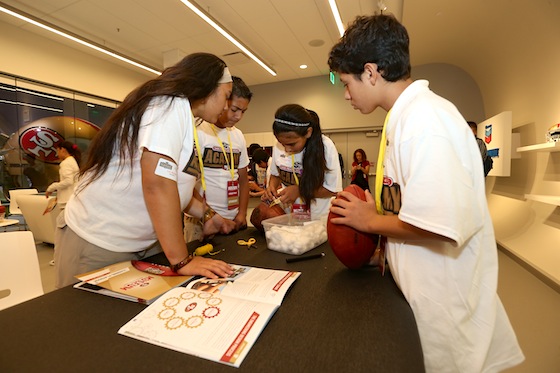Do STEM and Sports Make a Good Match?
A MiddleWeb Blog
 The mantra just doesn’t let up:
The mantra just doesn’t let up:
►The United States has fallen behind other nations with educating students in science, technology, engineering, and mathematics (STEM) fields.
►Only 16 percent of U.S. high school students are proficient in math and actively pursuing STEM careers.
►These trends must be reversed. Every passing year that America’s students don’t improve their STEM involvement, the gap widens between the U.S. and other countries.
From the Federal government, to corporations, to local school systems and schools, STEM seems to be on everyone’s radar. But to solve the problem of lackluster student interest we need to go beyond simply offering STEM course work.
We need better ways to raise awareness about 21st century problems in need of solutions. We need to get more students interested in science, technology, engineering and math, and do this at earlier ages. How are we going to do that?
Sports to the rescue?
I’ll have to admit to doing a double take when the idea of mixing STEM education into sports first crossed my own radar. I expected that other academic subjects would look at ways to incorporate pieces of STEM curriculum and skills into their areas. But sports? Really? I pondered this seemingly odd merger. How would that work?

For example, how might they make an improved helmet, a better hockey puck, or an athletic shoe that’s more successful in the sports industry? Why is a golf ball dimpled and can they improve on that design? Many kids who are otherwise disinterested in STEM topics might relate to those kinds of engineering problems.

And the sports industry is already on top of it. Take a look at some ways in which sports and STEM already intersect, and places where you might find ideas.
Sports-STEM intersections
Take a look at the online site, SportTechie, which contends that sports can play a major role in STEM engagement. It spotlights ways people with STEM skills can create, design, and improve sports equipment and safety, along with other innovations. You can scroll down a long list of technical improvements (and needed improvements) in sports equipment.
In its #SportsInSTEMSeries of posts, the SportTechie website illustrates how sports are motivating and training students in STEM. For example, the San Francisco 49ers have a STEM hub (the Chevron STEM Zone) inside high-tech Levi’s Stadium where students can learn in-depth STEM principles that apply to football.
While on the field, kids learn about solar energy considerations and irrigation practices. In the stadium they examine recycling issues. Students also work on projects that challenge them to use STEM concepts such as momentum, force, and trajectory. During one such project they work on how to propel a marshmallow (representing a football), over a miniature goal post and score a field goal.
For more ideas, explore Time Warner Cable’s initiative, Connect a Million Minds. The site’s STEM in Sports page sets the tone: From the physics behind a perfect football spiral to the chemistry of a red hot race car, science, technology, engineering and math help to power many of your favorite sports. STEM in Sports gives you tools to inspire your kids to learn more about these subjects through sports you both love.
Click on the site’s Parents & Educators link and you’ll locate learning guides for games and activities to inspire kids to learn more about math and science through sports. Individual sports are also highlighted with STEM components prominently featured. And check out this series of YouTube videos with popular sports figures touting the value of science and math in sports. You’ll find enough ideas and tools at Connect a Million Minds to come up with your own exciting STEM in Sports lessons.
NASA and others are in the game
Many teachers and kids in 2014 kicked off some STEM lessons with NASA’s STEM-in-Sports Online Series. They learned the science behind scoring a touchdown, throwing a slam-dunk or a hitting a homerun with free distance-learning program called NASA STEM Mania.

Sam Strickling, the Product Marketing Engineer for National Instruments LabVIEW, works with students across the nation to develop engineering projects that demonstrate sports science concepts. One of his earliest and most popular examples of these student-led sports engineering projects is a swimming study.
College students were challenged to design and build a training platform that would measure and analyze swimmers’ reaction speeds and body position as they entered the water. And their STEM work really paid off! The platform they designed is currently being evaluated for use by the United States Olympic Committee.

“Sports are much more than a STEM education vehicle,” she told SportTechie. “They present exciting and challenging real world applications of STEM principles, like physics and aerodynamics–even sports biomechanics and kinesiology, as it pertains to player performance. Many sports-related careers are STEM specific, including statisticians and sports therapists, among others.”
Think about it: Sports can involve students of all ages in interesting STEM projects and activities. Sports is a way to make STEM cool and relevant to kids. If you can incorporate sports into your STEM projects, you’ll raise the enthusiasm level for many students. And if the sports programs at your school will incorporate STEM principles into their programs, your kids will have the best of both worlds.
I think that’s a big deal. Three cheers for STEM in Sports!






























